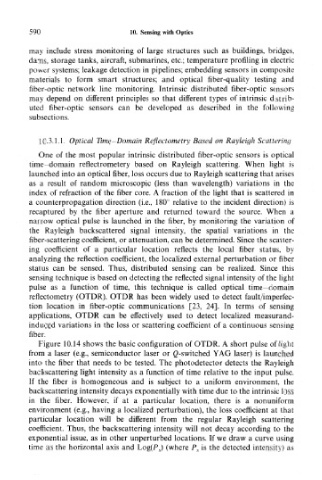Page 606 - Introduction to Information Optics
P. 606
590 10. Sensing with Optics
may include stress monitoring of large structures such as buildings, bridges,
dams, storage tanks, aircraft, submarines, etc.; temperature profiling in electric
power systems; leakage detection in pipelines; embedding sensors in composite
materials to form smart structures; and optical fiber-quality testing and
fiber-optic network line monitoring. Intrinsic distributed fiber-optic sensors
may depend on different principles so that different types of intrinsic distrib-
uted fiber-optic sensors can be developed as described in the following
subsections.
10.3.1.1, Optical Time-Domain Reflectometry Based on Rayleigh Scattering
One of the most popular intrinsic distributed fiber-optic sensors is optical
time domain reflectrometery based on Rayleigh scattering. When light is
launched into an optical fiber, loss occurs due to Rayleigh scattering that arises
as a result of random microscopic (less than wavelength) variations in the
index of refraction of the fiber core. A fraction of the light that is scattered in
a counterpropagation direction (i.e., 180° relative to the incident direction) is
recaptured by the fiber aperture and returned toward the source. When a
narrow optical pulse is launched in the fiber, by monitoring the variation of
the Rayleigh backscattered signal intensity, the spatial variations in the
fiber-scattering coefficient, or attenuation, can be determined. Since the scatter-
ing coefficient of a particular location reflects the local fiber status, by
analyzing the reflection coefficient, the localized external perturbation or fiber
status can be sensed. Thus, distributed sensing can be realized. Since this
sensing technique is based on detecting the reflected signal intensity of the light
pulse as a function of time, this technique is called optical time-domain
reflectometry (OTDR). OTDR has been widely used to detect fault/imperfec-
tion location in fiber-optic communications [23, 24]. In terms of sensing
applications, OTDR can be effectively used to detect localized measurand-
induced variations in the loss or scattering coefficient of a continuous sensing
fiber.
Figure 10.14 shows the basic configuration of OTDR. A short pulse of tight
from a laser (e.g., semiconductor laser or Q-switched YAG laser) is launched
into the fiber that needs to be tested. The photodetector detects the Rayleigh
backscattering light intensity as a function of time relative to the input pulse.
If the fiber is homogeneous and is subject to a uniform environment, the
backscattering intensity decays exponentially with time due to the intrinsic loss
in the fiber. However, if at a particular location, there is a nonuniforrn
environment (e.g., having a localized perturbation), the loss coefficient at that
particular location will be different from the regular Rayleigh scattering
coefficient. Thus, the backscattering intensity will not decay according to the
exponential issue, as in other unperturbed locations. If we draw a curve using
time as the horizontal axis and Log(P s) (where P s is the detected intensity) as

